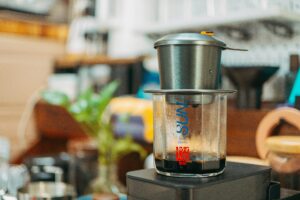Are you a coffee enthusiast looking to master the art of roasting your own beans? Roasting coffee beans at home can be a rewarding experience, allowing you to customize flavors to create your perfect cup. This guide will walk you through the process of roasting coffee beans, highlighting important techniques, tips, and tricks to get the most flavor from your roast.
The Journey from Bean to Brew
Roasting coffee beans transforms their chemical and physical properties, bringing out the rich flavors and aromas we associate with a good cup of coffee. Raw green coffee beans are heated to various temperatures, developing complex flavor profiles. Understanding this process is key to creating your ideal roast.
Why Roast Your Own Coffee Beans?
Roasting your own coffee beans offers several benefits. Firstly, freshness is guaranteed. Coffee begins to lose its flavor shortly after roasting, so home roasting ensures you always have fresh beans. Secondly, you have complete control over the roast level, allowing you to experiment with different flavors and strengths.
What You’ll Need to Get Started
Before you begin roasting, gather the necessary equipment. You’ll need raw green coffee beans, a roasting device (such as an air popcorn popper, stovetop roaster, or dedicated coffee roaster), a cooling tray, and a storage container. Having these tools on hand will make the roasting process smoother and more enjoyable.
Choosing the Right Coffee Beans
The type of coffee beans you choose significantly impacts the flavor of your roast. Coffee beans come from various regions, each with distinct characteristics. For example, Ethiopian beans are known for their fruity, wine-like flavors, while Colombian beans offer a balanced, mild taste.
Understanding Bean Varieties
There are two main types of coffee beans: Arabica and Robusta. Arabica beans are considered superior, boasting a wider range of flavors and less bitterness. Robusta beans, on the other hand, have a stronger, more bitter taste and higher caffeine content. Most specialty coffee enthusiasts prefer Arabica beans for their complex flavor profiles.
Sourcing High-Quality Beans
To achieve the best results, source high-quality green coffee beans from reputable suppliers. Look for beans that are uniform in size and color, as inconsistencies can lead to uneven roasting. Specialty coffee shops and online retailers often offer a wide selection of green beans from various regions.
Experimenting with Blends
Don’t be afraid to experiment with different bean blends. Combining beans from various regions can create unique flavor profiles, adding depth and complexity to your coffee. Keep notes on your experiments, recording the types of beans used, roast levels, and resulting flavors to refine your blends over time.
Roasting Techniques and Methods
There are several methods to roast coffee beans, each with its own advantages and disadvantages. The method you choose depends on your equipment, preferences, and desired level of control over the roast.
Air Roasting
Air roasting involves using hot air to roast the beans evenly. This method is quick and efficient, producing a clean, bright flavor. An air popcorn popper is a popular choice for home air roasting. Simply add the beans to the popper, set the heat, and stir occasionally to ensure even roasting.
Drum Roasting
Drum roasting uses a rotating drum to roast the beans. This method provides more control over the roast, allowing for longer roasting times and deeper flavors. Stovetop roasters and dedicated coffee roasters typically use drum roasting. Keep the temperature steady and monitor the beans closely to avoid over-roasting.
Pan Roasting
Pan roasting is a simple and affordable method, requiring only a heavy skillet or cast-iron pan. Although it offers less control over the roast, it allows for hands-on experience. Stir the beans continuously over medium heat, ensuring even roasting. This method produces a rustic, smoky flavor.
The Roasting Process Step-by-Step
Now that you have your beans and equipment ready, it’s time to start roasting. Follow these steps to achieve a flavorful roast:
Preheat Your Roaster
Preheat your roasting device to the desired temperature. Preheating ensures an even roast and helps the beans reach their target temperature more quickly. Aim for a starting temperature of around 350°F (175°C) and adjust as necessary based on your roaster and desired roast level.
Add the Beans
Once your roaster is preheated, add the green coffee beans. Spread them out evenly to ensure uniform roasting. If you’re using a drum or pan roaster, continuously stir or shake the beans to prevent burning and ensure even heat distribution.
Monitor the Roast
Keep a close eye on the beans as they roast. The roasting process involves several stages, each producing different flavors and aromas. Listen for the first crack, a popping sound that indicates the beans reaching a light roast. For a darker roast, continue roasting until you hear the second crack.
WantJoin Insulated Beverage Dispenser

- 75 Cup Hot&Cold water Urn for Catering
- Stainless Steel
- Premium 12 L/3.2 Gallon
- Hot Drink Dispenser
Cooling the Beans
Once your beans reach the desired roast level, remove them from the heat and cool them quickly. Spread the beans out on a cooling tray or use a fan to expedite the cooling process. Rapid cooling helps preserve the flavors and prevents over-roasting.
Degassing and Storing
Allow the roasted beans to degas for 12-24 hours. During this time, they release carbon dioxide, which can affect the flavor of your brew. Store the beans in an airtight container in a cool, dark place to maintain freshness. Use the beans within two weeks for optimal flavor.
Tasting and Adjusting Your Roast
After roasting, it’s time to taste your coffee and make any necessary adjustments. Brewing a small batch allows you to evaluate the flavor profile and identify areas for improvement.
Tasting Notes and Evaluation
Use the tasting notes included with your green beans as a reference. Evaluate the aroma, acidity, body, and flavor of your coffee. Take note of any bitterness or undesirable flavors, as these can indicate over-roasting or uneven roasting.
Making Adjustments
Based on your tasting notes, make adjustments to your roasting process. If the coffee is too bitter, try reducing the roast time or lowering the temperature. If the flavor is too mild, increase the roast time or raise the temperature. Keep experimenting until you achieve your desired flavor profile.
Refining Your Technique
Roasting coffee is an art that improves with practice. Keep detailed records of each roast, noting the beans used, roast level, and resulting flavors. Over time, you’ll develop a deeper understanding of how different variables affect the final product, allowing you to refine your technique and create consistently delicious coffee.
Building Your Home Coffee Roastery
Once you’ve mastered the basics of roasting, consider expanding your setup to create a home coffee roastery. Investing in additional equipment and experimenting with different beans and roast levels can take your coffee experience to the next level.
Upgrading Your Equipment
Consider upgrading to a dedicated coffee roaster for more precise control over the roasting process. These machines offer advanced features such as temperature control, airflow adjustment, and data logging, allowing you to fine-tune your roasts and achieve consistent results.
Exploring New Beans
Experiment with beans from different regions and growing conditions to expand your flavor palette. Specialty coffee shops and online retailers often offer limited-edition beans and rare varieties, providing exciting opportunities to discover new flavors and aromas.
Sharing Your Creations
Share your roasted coffee with friends, family, and fellow coffee enthusiasts. Host tasting sessions to showcase your creations and gather feedback. Sharing your passion for coffee can lead to new friendships and a deeper appreciation for the art of roasting.
Common Challenges and Solutions
Roasting coffee beans at home can present some challenges. Being aware of these issues and knowing how to address them will help you achieve better results.
Uneven Roasting
Uneven roasting can result from inconsistent stirring or uneven heat distribution. To address this, ensure you’re using the right equipment and techniques for your chosen roasting method. Stir or shake the beans continuously and monitor the temperature closely.
Over-Roasting
Over-roasting can produce burnt or bitter flavors. To avoid this, keep a close eye on the beans during the roasting process and remove them from the heat once they reach the desired roast level. Cooling the beans quickly also helps prevent over-roasting.
Stale Beans
Stale beans result from improper storage or extended storage time. Store your roasted beans in an airtight container in a cool, dark place to maintain freshness. Use the beans within two weeks for the best flavor.
Integrating Roasting into Your Routine
Incorporating coffee roasting into your daily routine can enhance your overall coffee experience. By dedicating time to roast your beans, you’ll develop a deeper appreciation for the process and enjoy a fresher, more flavorful cup.
Setting a Roasting Schedule
Establish a regular roasting schedule to ensure you always have fresh beans on hand. Roast small batches frequently to maintain freshness and experiment with different beans and roast levels. A consistent schedule will help you refine your technique and achieve better results.
Incorporating Brewing Methods
Pair your freshly roasted beans with different brewing methods to explore new flavors and textures. Experiment with pour-over, French press, AeroPress, and espresso to find the best method for each roast. Each brewing method highlights different aspects of the coffee, offering unique experiences with every cup.
Sharing Your Knowledge
Share your roasting knowledge and experiences with others. Join online forums, attend local coffee events, and connect with fellow coffee enthusiasts to exchange tips and ideas. Sharing your passion for coffee can lead to new friendships and inspire others to start their roasting journeys.
Conclusion
Roasting coffee beans at home is a rewarding and enjoyable hobby that allows you to create personalized, flavorful coffee. By following the steps outlined in this guide, you’ll be well on your way to mastering the art of coffee roasting. Remember to experiment with different beans, roast levels, and techniques to find your perfect cup.
Ready to elevate your coffee experience? Sign up for our coffee subscription service to receive expertly curated beans and exclusive deals delivered right to your door. Join our community of coffee enthusiasts and start roasting your way to the perfect cup today.
FAQs
What is the best temperature for roasting coffee beans?
The ideal temperature for roasting coffee beans varies depending on the desired roast level. Generally, a starting temperature of 350°F (175°C) works well, but you can adjust it based on your specific roaster and preferences.
How long should I roast coffee beans?
Roasting times vary depending on the method and desired roast level. Light roasts typically take 5-7 minutes, while dark roasts can take up to 15 minutes. Monitor the beans closely and listen for the first and second cracks to determine the roast level.
Can I roast coffee beans without special equipment?
Yes, you can roast coffee beans using simple methods like pan roasting or using an air popcorn popper. While these methods may offer less control over the roast, they can still produce delicious results and provide a hands-on experience.






